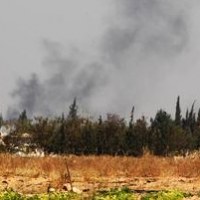![]()
Mon, Aug 16, 2010 | The Meir Amit Intelligence and Terrorism Information Center
Hezbollah and Hamas Television
A number of satellite companies (including Western companies) continue providing communication services for Hezbollah and Hamas’ television and radio, even though restrictions have been imposed by Europe and the United States. Supported by foreign companies, Hezbollah and Hamas are able to extend their range around the world, including Muslim communities
Overview
Hezbollah and Hamas operate an extensive media infrastructure, which includes satellite television channels and radio stations. Their media network spreads incitement and hate propaganda against Israel (and occasionally against the Jewish people) and the West, not only to Palestinian and Arab-Muslim target audiences in the Middle East, but to various target audiences around the world (including Muslim communities in Western countries).
Hezbollah and Hamas are receive services from Nilesat, and Egyptian satellite company, and Arabsat, a pan-Arab company, in which Saudi Arabia is the dominant partner. They receive the services despite their difficult relations with the countries which control the satellite-owning companies, especially Egypt (which recently viciously attacked Iran and Hamas for the rockets Hamas fired at Eilat and the Jordanian city of Aqaba from the Sinai Peninsula).
In the past the United States and European countries imposed restrictions on broadcasting Hezbollah and Hamas’ incitement and propaganda programs, and even outlawed their media. However, both organizations found ways to circumvent the restrictions. An updated examination carried out by the Meir Amit ITIC revealed that commercial companies still provide Hezbollah and Hamas with communications services and in effect help them spread their hate messages throughout the world, even beyond the reception ranges of Nilesat and Arabsat.
According to our information, most of the aforementioned commercial companies, whose services are used by Hezbollah and Hamas, are Arab as well as Russian and Indonesian.
Television Channels
Hezbollah – Al-Manar TV
Al-Manar TV is Hezbollah’s most important medium and enjoys immense popularity in the Middle East. Its programs preach the adoption of terrorism, reject the State of Israel’s right to exist and spread the Iranian version of radical Islam. In recent years the international community, including the United States, European countries and South American countries, has waged a struggle against broadcasting its programs.
So far there has been only partial success. Although some of its broadcasts have been limited, their reception has not been completely prevented in countries outside the Middle East. Today Al-Manar TV is supported by two non-Middle Eastern communications companies: the Indonesian company IndoSat and the Russian company RSCC. As a result, Hezbollah has extended the range of Hezbollah’s television reception to Southeast Asia and Oceania, Iran, Central Asia and large parts of Europe. Some details about the companies is the following:
The Indonesian IndoSat
IndoSat has a satellite called Palapa-D, also known as Palapa D-1. It was launched in 2009 and is expected to remain in space for ten years. It broadcasts to Indonesia, Malaysia, the Philippines, Korea, Australia, New Zealand and the smaller Southwest Pacific islands, Japan, China, India, Southern Russia, Iran and Central Asia, as well as parts of the Middle East and Africa. IndoSat was originally government-owned, but in 2003 the government sold most of its stocks. Today Qatar Telecom (Qtel) holds about 65% of the stocks, directly and indirectly.
In the past the Jewish community in Australia protested Al-Manar TV’s incitement hate propaganda broadcasts, which reached the country via IndoSat. However, the Australian government, apparently both unable and unwilling, took no steps to curtail reception of Al-Manar TV broadcasts.
The Russian RSCC
On July 18, 2010, Al-Manar TV began using the services of the Russian RSCC (Russian Satellite Communications Company) to broadcast its programs. The RSCC is the national communications satellite operator throughout Russia and provides its services to other clients around the world. Its Express AM22 satellite was launched in 2003. The company also holds stock in the French Eutelsat and Intelsat (See below). The company’s broadcasts are received in most of Europe and Russia, as well as in the Middle East and Africa.
Hamas – Al-Aqsa TV
Al-Aqsa TV is Hamas’ most important television channel. It began broadcasting on January 9, 2006, after Hamas won the Palestinian Legislative Council elections in the Gaza Strip. Since its inception it has been the movement’s main medium for spreading hate propaganda and inciting violence against Israel.
Today Al-Aqsa TV’s broadcasts are supported by the Noorsat Global Satellite Communication Company, which provides satellite communications services to the Arab world. Its offices are located in Bahrain and Oman.[1]
To disseminate Al-Aqsa TV broadcasts throughout Europe, Noorsat uses the communications satellites of Eutelsat, a French company based in Paris. Eutelsat began as an inter-governmental European corporation which was privatized in 2001 and today is French and privately owned. It uses the services of the Atlantic Bird 4 satellite, whose broadcasts cover North Africa, the Middle East, South and Central Europe, parts of Southern Russia, the republics of Central Asia, Iran, Pakistan, Afghanistan and parts of India.[2] The Egyptian company Nilesat which broadcasts Al-Aqsa TV uses the same satellite.
Following a French government appeal to the company not to provide Al-Aqsa TV with its services, Eutelsat agreed to remove its broadcasts (Wall Street Journal, June 10, 2010). It was not the first time Eutelsat received a warning. In 2008 and 2009 it was warned by the European Commissioner that by providing Al-Aqsa TV with satellite services it was breaking the French law against broadcasting incitement and hate propaganda. However, in retrospect it became clear that the warnings were not heeded and did not lead to change in the nature of the programs broadcast by the company’s satellite.[3]
Update – Mon Aug 23, 2010:
On June 7, 2010, the French government instructed its broadcasting authority to stop Al-Aqsa TV’s broadcasts, which had been using the French communications satellite Eutelsat, based in Paris. The instructions were given after France was warned by the European Commission that Al-Aqsa TV had repeatedly violated European laws by broadcasting incitement to violence, especially against Israel and Jews (Agence France-Presse, June 7, 2010).Hamas responded immediately to repeal the ban. Al-Aqsa TV directors appealed to jurists and lawyers for legal counsel. However, their efforts came to a dead end because the condition for repealing the ban was a change in the nature of the channel’s broadcasts. Thus on June 24, 2010, Noorsat announced that it would no longer broadcast Al-Aqsa TV.
According to Muhammad Tharia, deputy director of Al-Aqsa TV, immediately following the termination of its broadcasts by Noorsat, Al-Aqsa TV reached an agreement with a new intermediary called Gulfsat, based in Kuwait. He added that Al-Aqsa TV wanted to extend its broadcasts to countries in South America, such as Brazil, Argentina, Chile, Colombia and Cuba. He also promised that its broadcasts would reach Kurdistan, Turkmenistan, Kazakhstan, Tajikistan, Pakistan, Eastern China and Russia (Al-Aqsa TV, June 25, 2010).
Gulfsat Communications was established in 1995, a cooperative project with the Kuwait Communications Ministry and the American Hughes Network Systems. The company is a subsidiary of United Networks, which belongs to KIPCO, a leading investment company in the region. Gulfsat provides Al-Aqsa TV with services via the Atlantic Bird 2 communications satellite, which also belongs to the French Eutelsat. Its range is similar to that of Atlantic Bird 4, which was used by Noorsat.
Hamas – Al-Quds TV
Al-Quds TV began broadcasting on November 11, 2008. Hamas’ second satellite channel, it is another component of the movement’s vast media infrastructure. It is registered in London by Arab and Palestinian businessmen and media personnel, and represents itself as expressing general Palestinian positions, but is in effect just another Hamas mouthpiece.[4]
Al-Quds TV is also supported by the services of Eutelsat and its Atlantic Bird 4 satellite, which broadcasts radio and television. The satellite covers North Africa, the Middle East, South and Central Europe, the southern part of Russia, the republics of Central Asia, Iran, Pakistan, Afghanistan and parts of India.
Radio Stations
Hezbollah – Radio Nur
Hezbollah’s Radio Nur broadcasts in Arabic from Beirut. It began operating on May 9, 1988, with the support of the Iranian Revolutionary Guards. It broadcasts the news five times a day and devotes air time to religious programs emphasizing self-sacrifice and fighting Israel.
To broadcast its programs, Radio Nur is supported by the Spanish company Hispasat, which uses Hispasat’s satellites 1C and 1D. The satellite belongs to the Spanish Union, established as a government company and still partially connected to the Spanish government, which holds about one fourth of its stocks (as does the French Eutelsat). The satellite’s broadcasts cover most of Western Europe and Turkey, South America and broad sections of the United States.
Hamas – Radio Sawt al-Aqsa
Sawt al-Aqsa is one of Hamas’ radio stations in the Gaza Strip and by far the most popular. It is a local station operated by the de facto Hamas administration, and broadcasts mainly local news.
Sawt al-Aqsa also uses the services of the French Eutelsat through the Atlantic Bird 4 satellite (See above).
Notes:
[1] For further information see the July 15, 2010 post, “France Banning Al-Aqsa TV for Inciting Hatred and Encouraging Terrorism.”
[2] For further information see the July 18, 2010 post, “Hamas Circumvents France’s Ban on Al-Aqsa TV.”
[3] For further information see the January 11, 2009 bulletin, “Terrorism and the media: Hamas’s Al-Aqsa TV no longer broadcasts via the European Eurobird satellite.”
[4] For further information see the November 18, 2008 bulletin, “Al-Quds, Hamas’s second satellite TV channel, went on air on November 11, further expanding that movement’s media empire.”



 RSS
RSS
















Hezbollah and Hamas Television #hezbollah #hamas #antisemitism #islamism #media http://j.mp/9MplxC
[…] posted here: Hezbollah and Hamas Television | Middle East Affairs Information … // Hezbollah and Hamas Television | Middle East Affairs Information … listing […]
RT @CrethiPlethi: Hezbollah and Hamas Television #hezbollah #hamas #antisemitism #islamism #media http://j.mp/9MplxC
[…] [2] For further information see the August 18, 2010 article, “Hezbollah and Hamas Television”. […]
[…] [2] Read also the August 18, 2010, post Hezbollah and Hamas Television. […]
[…] [6] For details, see the August 18, 2010 article: “Hezbollah and Hamas Television”. […]
[…] He ran the Hizbullah owned Islamicist satellite TV station, Al-Manar, which France and Australia banned because of its intensive anti-Semitic content. Mousawi was invited again the following year but the […]